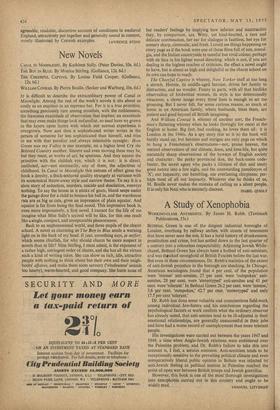Medieval Cornwall
MEDIEVAL CORNWALL. By L. E. Elliott-Binns. (Methuen, 35s.) IT is probably true to say—though only at the risk of inducing apoplexy all the way from Berwick to Brighton—that Cornwall inspires a more intense local patriotism among its natives than any other English county. One reason, of course, is that Cornwall is more a country than a county. By race and language, geography and poverty, she was long' cut off from the rest of England. Nor has any other English county been better served by her historians. Admittedly there has appeared only one volume and a bit in the Victoria County History (what is the reason for this lack of enterprise?). But she can boast of the most engaging product of the Elizabethan antiquarians, Richard Carew's Survey, an exhaustive work on her basic industry in Mr. Lewis's book on The Stannaries, and two admirable studies of her history during the sixteenth and seventeenth centuries, those of Dr. Rowse on Tudor Cornwall, and of Miss Coate on Cornwall in the Great Civil War. Moreover, Professor Pevsner 'has already trained his restless architectural searchlight within her boundaries.
Local history, as distinct from. local topography, is not easy to write, and those who succeed in the task, like Dr. Hoskins, are a rare minority. There is 'need to avoid on the one hand an inter- minable narrative of the trivial doings around the parish pump, and on the other a summary of national events with appropriate local allusions. From the first pitfall Canon Elliott-Binns assures us in his preface that he is safeguarded; but he has tumbled heavily into the second. For example, we are told all about the Hundred Years War, punctuated by remarks like 'The Black Prince's following no doubt included some Cornishmen' and 'Cornwall no doubt shared in the general rejoicing.' Indeed a good deal of this repetitive, inflated volume consists of summaries of general English history and English conditions with particular examples drawn from Cornwall. One of the illustrations, helpfully described as 'from a fifteenth-century MS,' does not even have any Cornish associations at all, but is used to fill out a chapter on the workings of the manorial system.
All this is a great pity. For Canon Elliott-Binns has undoubtedly covered a great deal of ground in his researches, though which references are due to himself and which are derived from the enormous mass of material collected by the late Charles Hendersbn is nowhere made clear. With• Henderson's MSS and publisher essays behind, .and the volumes of Dr. Rowse and Miss Coale ahead to point the way, there was the opportunity for a really useful study of medieval Cornwall. What we have instead is an
agreeable, readable, discursive account of conditions in medieval England, attractively put together and generally sound in content,
mostly illustrated by Cornish examples. LAWRENCE STONE



































 Previous page
Previous page